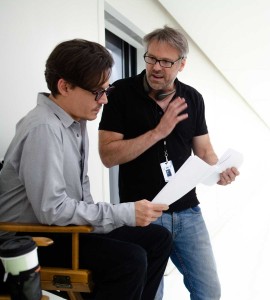
Wally Pfister has a self-proclaimed love-hate relationship with technology, evident throughout his directing debut, Transcendence, which opens tomorrow. This ambivalence shows up in his choice of narrative, themes, locations and, most notably, in the fact that he shot the movie in 35 mm anamorphic and eschewed a DI for a photochemical finish. He and his hand-picked cinematographer, Jess Hall, joined moderator David Geffner on stage at NAB last week in Las Vegas to discuss the making of the movie.
Geffner, editor of ICG Magazine, set the stage for the hour-long conversation by noting that both men are passionate about shooting on 35 mm film. Pfister, who was DP on all of Chris Nolan’s films to date – with the exception of his most recent, Interstellar – won an Oscar for the cinematography on Inception, while Hall was DP on Son of Rambow (shot in 35 mm anamorphic), Hot Fuzz and last year’s The Spectacular Now.
Both Pfister and Hall spoke of the impact of seeing 2001: A Space Odyssey as eight-year olds, and how the experience affected who they have become as filmmakers. In fact, because Stanley Kubrick’s film had such a huge influence on his life as a filmmaker, Pfister held a special screening of a 70 mm print of 2001 for the crew of Transcendence in pre-production. It was important for him that his crew understand how influential that film was to his style and that they see it as the gold standard of what he hoped to accomplish with Transcendence.
“For me it was about that film on every level: the visual aspect of the storytelling, the design, the pacing and of course the subject matter,” said Pfister. “The subject matter is about artificial intelligence,” which is also central to Transcendence, a story of a scientist (played by Johnny Depp) who uploads his consciousness to a supercomputer and lives on after his body dies. It allowed Pfister to explore some of the darker questions about our relationship with technology.
Shooting on film with photochemical finish
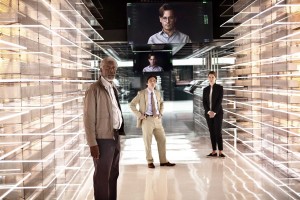
Transcendence was not only shot on film, it had a photochemical finish, which Geffner accurately said “is a very rare bird indeed” these days. Alcon Entertainment, which produced the film and had the ultimate say about whether film could be used, knew of Pfister’s love of film. “I don’t think there was any question about the film capture,” he said. “Because, strangely enough, to quote Mark Twain, ‘Rumours of my death have been greatly exaggerated.’ I think that’s the case with motion picture film because everybody says that nobody’s shooting it anymore and then, not only do you have J.J. Abrams doing Star Wars on it, but Stephen Spielberg’s still shooting it, Chris Nolan’s shooting it, Paul Thomas Anderson is shooting 65 mm.”
What was harder was arguing for a photochemical finish as film release prints are increasingly rare, with FotoKem being the only lab still in business. However, budgetary considerations won the day for Pfister. “What I was able to prove to the studio in my calculations was that we could save $300,000 by doing a film finish on this movie. That is the irony about the question of whether it’s cheaper to shoot digital or on film. If you’re doing a digital finish then you’re doing a DI rather than a film finish and it’s a lot more expensive than doing a photochemical finish.”
Seeing eye to eye on light
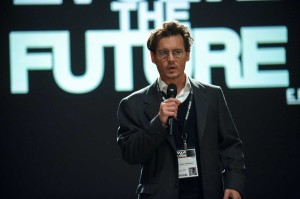
Hall also spoke of the influence that 2001 had on him, noting the depth that Kubrick went into in every aspect, including the research, the writing, the sense of adventure and the visual style of the movie. It demonstrated a dedication to the craft that he said they brought to the making of Transcendence, noting in particular the light. “Graham Greene said that the origin of the writer is in the childhood and I think Wally’s film childhood was natural light. And I used to wander around with my stills camera, photographing natural light.”
Hall’s use of light in Brideshead Revisited (2008) was one of the things that attracted Pfister to him. “In seeing that film, kind of looking at Jess’s work as a whole, I thought the lighting was fantastic. I thought it was a beautiful, naturalistic style. Very much reminded me of the kind of stuff I was doing and my aesthetic with the lighting.”
Hall admitted to being initially concerned that there might not be a place for his voice or style in a movie that was going to be directed by a cinematographer of Pfister’s reputation. Eventually, however, he realized it would be an amazing opportunity to work with a great filmmaker. It helped that, when they first talked at length about Transcendence, it was about the subject matter of the film. Hall ended up feeling that it would be a collaborative process, not just with the shooting, but with understanding and interpreting what the story was about.
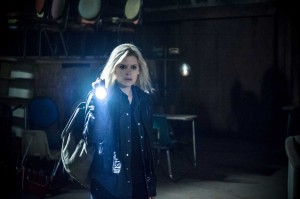
“Talking to Wally, we immediately got over to the dramatic content of the story and I felt that I understood what he was trying to say,” Hall explained. “That it was more than just making a glossy, beautiful film. He wanted to get into the dramatic structure of the story, the connections with the real world, the political implications, the moral dilemmas that were brought up through the technology. It felt like it was going to be a collaboration, not just on the visual level, but also dramatically.”
It might be challenging for a DP to make the transition to director, but Pfister was ready. “I’d done a lot with cinematography and I wanted to stretch a bit. More than anything else, I wanted to work with actors, create a narrative and play with performance.” He said that, although it was difficult to separate himself from his history of photography, he had to remove himself from focusing solely on the images. “My primary focus had to be interaction with the actors. I switched on and off because I spent a lot of time sitting with the actors rewriting dialogue, discussing what was going on in the scene, trying to find the essence of what was going on narratively. Also the image was very important to me. I had faith in and could trust Jess.” Nevertheless, there’s a lot of the DP left in the director. “I had to put the camera on my shoulder a few times. It’s so much fun.”
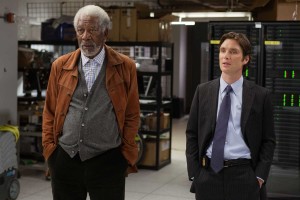
Pfister noted that it was very important to him to work with the team he has used from the many movies he’s done with Nolan. “Luckily Jess had done limited work in the States so I could push my guys on him. What I pitched to Jess early on was, as the director, I wanted to have the comfort factor of having the guys around me. I didn’t want to have Jess feel isolated by not having his say.” He knew that Hall would have an incredibly fast, efficient crew on his hands.
Holding communal dailies with the crew was another throwback that Pfister maintains a lot of faith in and was good for solidarity after a long day of shooting in the desert. “It’s incredibly important to be able to praise somebody’s work when it’s going in the right direction. In simplest terms, [communal dailies allowed us] to be able to understand where we were on coverage. You have to discipline yourself to do this, to track where you are in the picture. On any given shoot day, everyone knew what we’d done the day before.”
“It’s a fantastic process,” Hall concurred. “It’s subtle. You can respond to things very quickly. You’re working with a fixed set of parameters. It hasn’t gone through a DIT. I know exactly what lights I’ve used, I know what diffusion material I’ve used on the light, I know everything about that shot and I can change a minute thing if the skin tone is slightly off or if the lights are a bit too bright. With the photographic print you can react quickly to small details.”
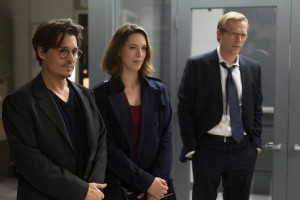
Many of the scenes in Transcendence are full of projections, with the Johnny Depp character appearing in various monitors and interacting live with Rebecca Hall. A live feed of Depp, who was in a sound-separated booth on the same set, was projected through Barco projectors onto these wall-mounted screens. Pfister wanted to capture all this in camera as this allowed for more honest interaction between the actors.
This made Hall’s job much harder, requiring plenty of testing of materials and techniques, but he found it more rewarding as well. “The end result was that we were in a black box surrounded by twelve projectors with Rebecca Hall wandering around talking to Johnny appearing in one glass panel, turning around and having him appear in another projection. And it was all done in camera. It was amazingly exciting to see that on set. We were able to make shots that we couldn’t conceive in CG. We could see the shots in front of us.”
To overcome the challenges of shooting in a room full of equipment and reflective surfaces, meaning that the crew and cameras might be seen in these surfaces, the crew all wore black and Hall controlled the lighting. He chose to light through small apertures in the ceiling, using directional lighting to keep it off the rear-projection screens. Entire shots were blocked, taking the lighting into account, and then this miniature plan was executed on a larger scale.
Tension between the organic and synthetic
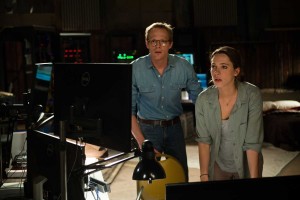
Geffner pointed out the many genres Transcendence encompasses: action, adventure, sci-fi, romantic drama, with a bit of zombie action thrown in. Depp’s character and his wife live in a cozy old house in the Berkeley Hills. Then, once he’s dead and his consciousness has been uploaded to the cloud, he ‘lives’ in a town in the desert, which was filmed in New Mexico. The Brightwood Data Center – the virtual world where Depp will live – is bright, sterile and futuristic.
The contrast between these locations allowed Pfister to explore the running tension in the movie between the organic and the synthetic. In the beginning it was important to him to have a warm, earthy environment where the couple exists together in corporeal form. The town of Brightwood was conceived as a dusty, California desert town, which the director envisioned as part of the decaying world. Brightwood Center is sterile, powered by 100 acres of solar panels.
Technology as religion
Geffner referred to the NAB show floor, where “technology as religion” plays out. When asked about his thoughts on the role of technology, Pfister referred to his movie as a cautionary tale. The statement it makes is that technology is in the hands of the people using it. “Personally I have a love-hate relationship with technology. I’m enslaved to my cellular phone… but at the same time I really don’t appreciate personal information shared.”
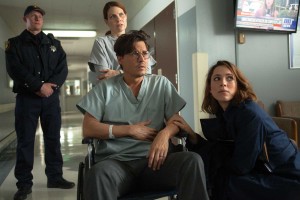 “You can have all the technology in the world, but if you don’t have the ideas it’s empty,” Hall concurred. “I still see film as an artist’s medium, as a visual art. The color separation and depth of color is unparalleled.”
“You can have all the technology in the world, but if you don’t have the ideas it’s empty,” Hall concurred. “I still see film as an artist’s medium, as a visual art. The color separation and depth of color is unparalleled.”
“There’s a physical depth to film that is really difficult to translate in the digital medium,” Pfister said. “I know it’s difficult if you’re only working in digital to see it. But one of the experiences that Jess and I had was an eye-opener and caught me off guard. We were working on the 4K DI for quite a while. We were very happy.” And then they watched them side by side. “There was a depth to the film – color, saturation and contrast – that surprised us both. It leapt off the screen.”
Pfister couldn’t help but make one last plug for film over digital. “I’d like to see the technology be more reliable. Having dabbled with digital cameras and then having the old Panaflex on the shoulder; those film cameras were much more reliable. Far fewer breakdowns. Maybe that will start to come with digital cameras in the future. Also, I really hope that the resolution continues to go up for digital cameras so that what we’re putting up on the huge screen is sharp and has as much color depth as possible.”
Although they made a DCP version as well, with a 4K scan and 4K color session, Pfister pointed out that to catch the resolution of 35 mm film requires scanning to digital at 8K-10K. “There’s still not a digital camera that can capture images in the same way [as film]. Those of us who are fighting for it really appreciate that aspect.”





